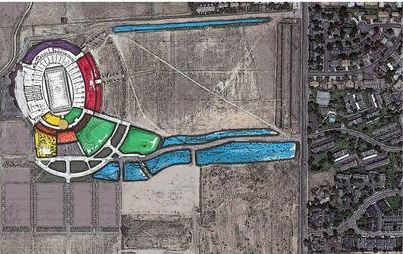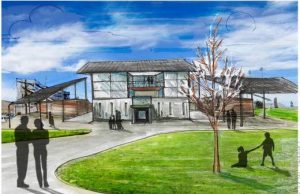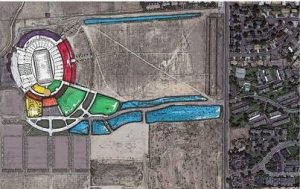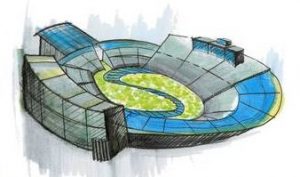Two CSU interior design students have spent the semester laying out their vision for Hughes Stadium as the first Net-Zero football stadium in the country.
In a series of Photoshop and marker renderings, junior design and merchandising majors Chris Ravana and Paul Vanderheiden show a revitalized Hughes complete with a raised solar panel field, new luxury boxes and restaurants on a rooftop deck along with many of the amenities proposed for the on-campus stadium CSU plans on building.
“This plan involves the city, students from all the different colleges contributing their knowledge,” said Vanderheiden. “This is really for everyone.”
In keeping with that philosophy, the students are donating their work to the CSU and Fort Collins community, including Save Our Stadium Hughes, the grassroots organization that opposes construction of an on-campus stadium. They hope it will encourage dialogue about best sustainability practices and let people know there are still alternatives to building a new stadium.
“I think it fits hand in glove with SOS’s vision of where we’re going…” said SOS organizer Bob Vangermeersch. “When Chris called me, I thought ‘this absolutely meshes with our vision.’”
In order to lessen the environmental impact, they planned the least amount of demolition as possible in regards to the new additions around Hughes, with an exoskeleton forming around the existing structure. Since the new on-campus stadium is being built in part to increase revenue to the university, money making features, like the rooftop restaurant, naming rights and marketing the sustainable features could be used to generate revenue at Hughes, Ravana said. .
Even though the plan is lacking on details, like total cost or blueprints, both Ravana and Vanderheiden said they wanted to show a viable alternative to the images that had been drawn for the on-campus stadium.
“We wanted to create this concept and put it out there for the people and students to improve on and grow, “Ravana said. “We haven’t had time or money to go into the detail of floor plans and blueprint and those will evolve with the project.”
The design fits in perfectly with CSU’s reputation as a “green” university with its history of environmental programs and initiatives, said Vanderheiden.
The biggest selling point of the revitalized stadium is the raised solar pavillion, which they hope can be built by companies that would donate panels and in exchange would have opportunities to market their involvement. A running tabulation of total energy generated would allow game-day attendees to see how much energy each company has put into the grid.
According to Ravana, if the electricity generated at the stadium over a year exceeds the amount of power it takes to run six games a year at Hughes Stadium, then the stadium would be the first Net-Zero football stadium in the country, something that fits with both the city of Fort Collins’ and CSU’s commitment to sustainability.
“I think that’s a claim CSU would want to be associated with,” Ravana said. “We have the personal to do it, the colleges to do it. How can you complain if it’s homespun?”
Four electric busses that pull energy off the solar panels would shuttle attendees back and forth from campus to Hughes stadium throughout gameday, saving people the need to drive the two miles from campus to the stadium.
“All the students could walk to the bus depot, which would probably be in closer proximity to walking to the new stadium and have an electric ride out, free, courtesy of the sun,” said Ravana.
While the university has it’s eyes firmly set on ramping up fundraising for the on-campus stadium, Amy Parsons, vice-president of university operations at CSU, said the university has a large number of students in a variety of fields, from landscape architecture, engineering, interior design and construction management, that work closely with the university contributing expertise on a wide range of university projects.
Although she hasn’t seen the renderings, Parsons said her office would be happy to meet with Ravana and Vanderheiden to hear their idea’s and see if they’d want to contribute to any on-going projects.
‘We see that as part of our mission, to work with students in these fields with regards to all our projects,” Parsons said.
If fundraising is successful and the university moves forward with construction, CSU is always looking at best building practices and keeps sustainability issues at the forefront of any construction projects on campus, said CSU spokesman Mike Hooker.
“Certainly a sustainable building is important to us, and we’ll be looking at all the ways to make our stadium, if it comes to the point where we can build it, to make it as environmentally sustainable as practical,” Hooker said.
Senior Reporter Austin Briggs can be reached at news@collegian.com.
















